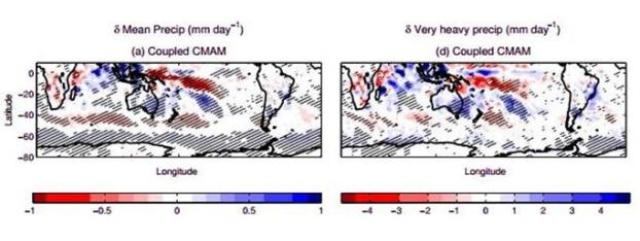Aug 31 2013
The new study by Prof. Sarah Kang from Ulsan National Institute of Science and Technology (UNIST), showed that the ozone depletion over the South Pole has affected the extreme daily precipitation in the austral summer, for December, January, and February (DJF). This work was published in the journal Geophysical Research Letter. (Title: “Modeling evidence that ozone depletion has impacted extreme precipitation in the austral summer”, Vol. 40, 1-6, doi:10.1002/grl.50796, 2013)
 Changes due to ozone hole of (left) mean precipitation and (right) 99th percentile daily precipitation
Changes due to ozone hole of (left) mean precipitation and (right) 99th percentile daily precipitation
The ozone hole over the Antarctic has affected atmospheric circulation in the Southern Hemisphere (SH) summer and Kang’s previous article in Science, analyzed the impact of ozone depletion to increased rainfall in the subtropics.
The new article is explaining about the impact of stratospheric ozone depletion on the extreme daily precipitation in the austral summer with two global climate models: the Canadian middle Atmosphere Model (CMAM) and the National Center for Atmospheric Research Community Atmospheric Mode (CAM3).
This research study has also been highlighted in the journal Nature Geoscience in September.
The research team led by Prof. Kang focused on a carefully conceived set of multimodel integrations forced only with observed stratospheric ozone changes. This single-forcing approach allows the research team to show extremes, in response to stratospheric ozone depletion and that these changes are likely of a dynamic rather than thermodynamic nature.
The ozone layer is a layer in the Earth’s atmosphere which absorbs most of the UV radiation and contains relatively high concentrations of ozone (O3). This ozone layer had been broken by the widespread use of man-made compounds containing chlorofluorocarbons (CFCs). After the discovery of the ozone hole, 1989 Montreal Protocol signed by 196 countries to reduce global CFC production to protect the ozone hole
In this research they discovered that the ozone depletion in the Antarctic area is associated with extreme rain in the austral summer and it would be used to forecast heavy rain and the natural disasters in the future.
Dangerous floods have occurred in every Australian state over the last 150 years. Some caused great loss of life, others devastated infrastructure. Between 1852 and 2011 at least 951 people were killed by floods, another 1326 were injured, and the cost of damage reached an estimated $4.76 million dollars.
Even though we can predict these natural disasters in advance, we can’t stop the flood but we can be prepared for it and reduce the damage.
“Due to limited data availability in the SH, it is hard to robustly determine observed changes in extreme precipitation,” said Prof. Kang. “However, since the recent Southern Hemisphere climate change is driven by the ozone hole, we can deduce the recent trend from our climate model integrations.”
“We would expand our research to see the correlation of the ozone depletion of the North Pole and the climate changes in the Northern Hemisphere,” said Prof. Kang, showing her future research plan.
This research was supported by the 2013 Creativity & Innovation Research Fund 1.130033 of UNIST (Ulsan National Institute of Science and Technology).
Fellow authors include: L.M. Polvani and G.J.P. Correa from Columbia University, J.C. Fyfe and M. Sigmond from Canadian Centre for Climate Modelling and Analysis, Environment Canada and S.-W. Son from Seoul National University, Korea.
*Extreme daily precipitation- The strong precipitation that would happen with 1% probability.
Homepage of Sarah Kang : https://sites.google.com/site/cdlunist/